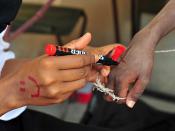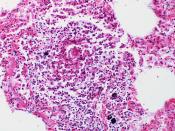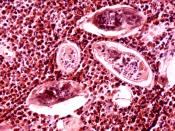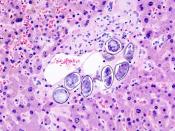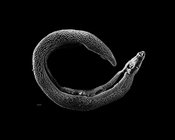An egg hatches, not a big egg, a microscopic egg that lets loose the parasite that will find its way through a big lake in Africa into a snail. The small parasite grows and becomes strong and resistant, leaving the snail and searching a human body before its 48 hours lifetime has elapsed. The parasite is so small it enters the body through the skin and begins to grow. Worms appear inside the body within a couple of weeks, laying eggs to expand the parasite and to get a shot at killing a defenseless person who most likely cant afford to pay the correct treatment. This is Schistosomiasis and it is the cause of a long horrible and agonizing death.
Genus species Schistosomiasis can also be called bilharzia sis, a parasitic disease that not only leads to a bad health, but could eventually lead to death if untreated. There are five types of flatworms, which are the most common in humans, which include Schistosoma mansoni, Schistosoma intercalatum, Schistosoma japonicum, Schistosoma mekongi, and Schistosoma haematobium scattered through countries in Africa, the Caribbean, the Eastern Mediterranean, South America, and Asia; especially the underdeveloped countries of these areas.
The parasite could lead to bladder cancer or kidney problems, liver and spleen problems, or a simple pain curable with expensive medicine.
Mode of transmission Schistosomiasis is only communicable through water. The cycle begins when an infected persons urine or fecal mater come in contact with a large body of water. Here, the egg hatches and the parasite travels into a hard shell snail, place where it reproduces and is set free to find a new home. The parasites have 48 hours to find a suitable body; in other words, a human body. The parasite enters the body by going through the skin and into the bloodstream. Here it grows into a worm that lays between 200 and 2000 eggs for five years approximately. The male worm is much bigger than the female. A male and a female pair together and forever when very young inside of the human and dedicate their lives to lay eggs, these worms lays the eggs that then go to the urinary track and are let loose when the person urinates. Then the process starts again, as the eggs hatch a find a snail.
Diagnosis In order to diagnose the disease correctly it is necessary to wait six to eight weeks after exposure and then take both a urine and a blood test that will examine in order to find either eggs or traces of the actual worm. The diagnosis procedure is quite simple and effective. It is also necessary when traveling to other countries and being in contact with water. The diagnosis is cheap and available with almost any doctor.
Pathogenesis The symptoms of Schistosomiasis begin one or two months after the infection. The host will develop a rash or itchy skin. He will also have fever, chills, cough, and muscle aches: however, most people don't experience anything in this stage of the disease. If the disease isn't treated it causes deformity and could even lead to death. The symptoms of the diseases aren't caused by the actual worm, rather by the eggs that the worm produc es and its reaction to the body. The eggs are found in the intestine and bladder; yet, they can be found in the brain very rarely or even in the spinal cord. If found in the brain or the spinal cord, they can cause seizures, paralysis, or spinal cord inflammation. If the host suffers from various attacks in a few years, then the body damages the intestines, the lungs, and the bladder. The organisms can only live for 48 hours in the water after growing inside a snail and cannot reenter another snail, they must find a suitable human body. Right after hatching, the miracidia (Larvae form) must find a snail very quickly or it will die (less than 4 hours); however, it is very easy to find both the snail and the human body in the rivers and lakes of Africa, Asia and Brazil. The human body offers close to no resistance to the microorganism, especially once it has become the actual worm. There are cures, but they are very expensive, yet simple.
Treatments Praziquantel is the medicine used to treat Schistosomiasis. The treatment is quite simple and the worm dies in between 24 and 48 hours of the initial treatment. Yet the medicine is very expensive and governments cannot afford to give the medication to the people who live in these third world countries. The medicine causes the worms muscles to contract and die of lack of movement and Pain. The treatment is very uncomfortable since the host will suffer from intense ache; yet it is better than suffering the horrible long death caused by this organism. The dosages are as follows.
Parasites Dosage Schistosoma haematobium 20 ç÷/çøáÿ 2 for 1 day S. mansoni 40 ç÷/çøáÿ 1 for 1 day S. japonicum 20 ç÷/çøáÿ 3 for 1 day Clonorchis sinenisis 25 ç÷/çøáÿ 3 for 1 day Opisthorchis viverrini 25 ç÷/çøáÿ 3 for 1 day Paragonimus westermani 25 ç÷/çøáÿ 3 for 2 days P. heterotremus 25 ç÷/çøáÿ 3 for 2 days Prevention and Control methods: No vaccine is available, but it is easy to prevent Schistosomiasis. Whenever in areas that are know for their Schistosomiasis, stay away from lakes, pools, rivers, and other water bodies that are probably infected. The government could control this problem by educating the population into using appropriate bathrooms and not "going to the bathroom" in the lakes, rivers, and other water bodies where people will use.
Resistance: The microorganism is beginning to show resistance to medicine. This is why it is imperative that the sickness is treated before there is no cure for it. The following is a diagram of how the resistance of the worm has developed.
Bibliography Jensen, Wright, Robinson, Microbiology for the Health Sciences, New Jersey: Prentice Hall Inc, 1997 www.biosci.ohio-state.edu/.../ schistosoma_lifecycle.html. Ohio State University Science department. 14-Nov-2002 http://www.who.int/ctd/schisto/disease.htm. World Health Organization. 14-Nov-2002 http://www.dpd.cdc.gov/dpdx/HTML/DiagnosticProcedures.htm. CDC Image library. 14-Nov-2002 Tanja Stchub, "Worm takes cues from host immune system". Lab Animal Magazine. January 2002: pg. 14
